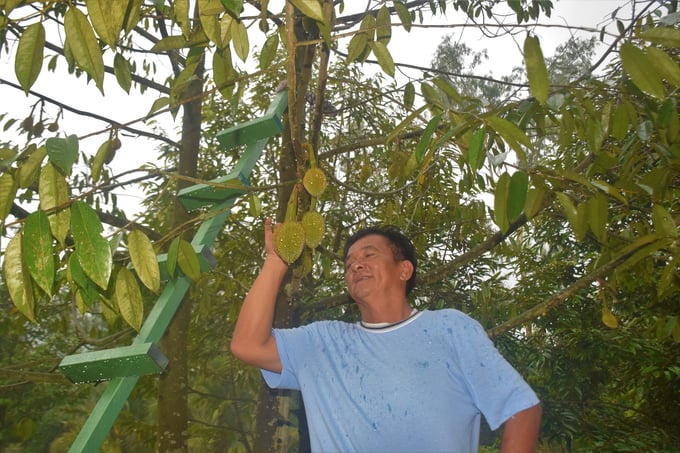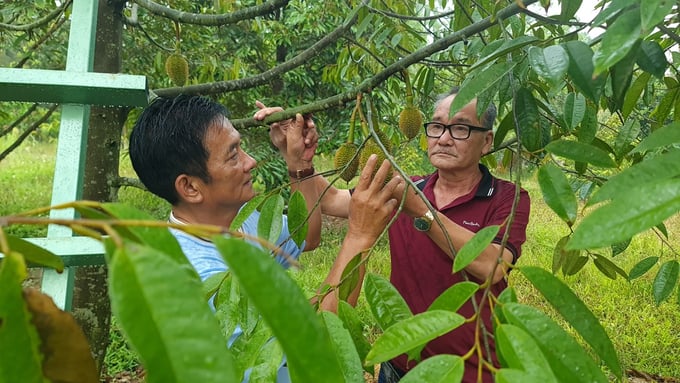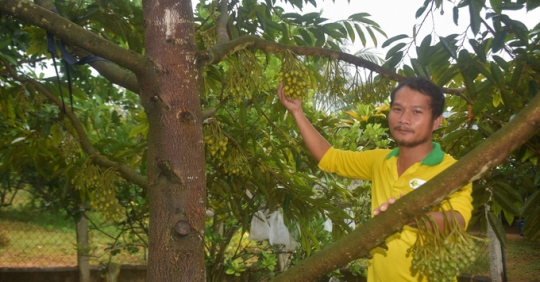[ad_1]
The organic durian farm producing fruit has great expectation as the durian crop in Binh Dinh is in the same season as other growing areas and hence sold at a good price…
The Advantage of the Unusual Durian Growing Area
Mr. Ho Nhat Can (b. 1966) was born in Hoai Tan District (Hoai Nhon City, Binh Dinh) and settled in Ho Chi Minh City for a long time. In 2016, Mr. Can returned to his hometown to lease 6 hectares of hilly land from the local government in Hoai Tan District and buy another 6 hectares to start an avocado and dwarf coconut palm farming enterprise. 3 years later the tree is bearing fruit, but the profitability is not high, while the effort to clean up the previous 12 hectares of land has cost a lot of money.

Mr. Ho Nhat Can next to durian trees bearing second year fruit at the farm in Hoai Tan District (Hoai Nhon City, Binh Dinh). Picture: Vu Dinh Thung.
Mr. Can thought that if he didn’t convert, he would have to ‘live with the pain’ of choosing the wrong plant for the rest of his life. In 2019, he decided to ditch all avocado and Siamese coconut trees and switch to durian. At present, its 3,000 durian trees have almost 1,000 fruit trees in their 2nd year, more than 1,000 trees are in the mature stage and 1,000 new trees are 1 year old.
“I failed to form the current farm of 3,000 durian trees with avocados and Siamese coconut trees, more than 4 billion dong were ‘put on a hat’ from my wife’s purse.” Almost 1,000 Ri6 durian trees gave fruit last year, although I did not intervene technically, the fruiting was very satisfactory, I left 10 trees at most, each fruit weighed more than 7 kg on average, very good quality. “This year I have hired a technician in the west to take care of it and I estimate that there will be 20 fruits left for each tree. Hopefully I can save some of the cost this season,” Mr. Can happily shared.
Discussing concerns that durian trees are getting hot in Vietnam and could easily lead to oversupply, Mr Can is confident that durian grown on Binh Dinh’s land has a very bright future as this tree is very good for the soil in Vietnam is suitable. Especially in the off-season harvest time with durian in the south, east and central highlands, so don’t worry about the yield.

This year nearly 1,000 first generation durian trees were planted by Mr. Ho Nhat. May bear fruit in the second year. Photo: Vu Dinh Thung.
“Last year all the durians in the central highlands were harvested, then it was my turn to harvest. After harvesting, I brought them back to Ho Chi Minh City for my daughter-in-law to sell at an average price of up to VND 55,000/kg. Each fruit weighed an average of 7 kg and was sold for almost VND 400,000/fruit,” said Mr. Dürfen.
Because the quality of the seedling determines the yield and quality of durian, Mr. Can selects a reputable local seedling supplier to place his trust in.
Ms. Tran Thi Kim Anh, Director of World Seedlings Company Limited in Hoai Tan District (Hoai Nhon City, Binh Dinh) said, “Previously, I worked at Binh Dinh Seed Company which was about to open a company. I have owned the company for 12 years now.”
Through my many years of activity in the field of plant varieties, I have selected a number of fruit varieties suitable for the climate and soil conditions of Binh Dinh, including durian. As for durians, there are many varieties in Vietnam now, but the soil in Binh Dinh is suitable for three lines of durians: Ri6, Thai and Musanking,” said Kim Anh.

Ms. Tran Thi Kim Anh, Director of Seedling World One Member Limited Liability Company in Hoai Tan Ward (Hoai Nhon City, Binh Dinh), a facility that provides durian seeds to Mr. Can’s farm. Picture: Vu Dinh Thung.
According to Mr. Ho Nhat Can, with proper care, the durian tree will bear fruit about three to three and a half years after planting. “Durian is a perennial plant. If you choose an inferior variety, the fruit will be small, the fruit will be small, the quality of the fruit is not good, by then it will be too late to regret, so I choose.” “The seed guaranteed by the company to buy. Behave properly,” shared Mr. Can.
Grow grass so that plants can grow from the grass
The path to Mr. Can’s durian farm is paved with concrete and the durian trees are in flower clusters that look very eye-catching. As we walked, Mr. Can told us, “On my farm, in addition to two southern technicians who manage the tending process, there are also six workers who are regularly present on the farm. Farm to check.” against crop pests, pull weeds and check sprinklers for clogs.”
What surprised us was that the grass under the durian trees still grew thick and lush, as if it had grown tall. As if he could read our minds, Mr. Tran Ngoc Vien (41 years old) from Hoai Duc community (Hoai Nhon town, Binh Dinh) is currently working at Seedling Supermarket (Welofarm) in Cho Lach (Ben Tre). Can come here The West guides the process of caring for durian trees and shares the following:

Mr. Ho Nhat Can next to 5-year-old durian trees is flowering at this time. Picture: Vu Dinh Thung.
“In this durian garden we don’t kill weeds, we just tend them. If the grass is too tall we cut the roots and keep them. Especially in the rainy season it is necessary to cut the grass regularly so that the water can drain well, the moisture in the soil does not increase and in the dry season it is very beneficial for the plants because the grass retains moisture and reduces the amount of water for the Irrigation. Grass roots crawled into the soil, giving durian plants a layer of oxygen to breathe.
Farmers often think that the grass eats up all the fertilizer they use to fertilize the crops. The grass will eat real manure, but then provide a great source of organic fertilizer to regenerate the plant. Since I spray the antagonistic fungus Trichoderma on the grass after cutting the grass, the grass decomposes and becomes organic fertilizer.
According to Mr. Vien, before returning to work on Mr. Can’s farm, he had been to many durian-growing areas in the western, eastern and central highlands; In the central region, vien entered the durian areas in Khanh Vinh, Khanh Son (Khanh Hoa) and on the Hinh River (Phu Yen). When Vien returned to Hoai Nhon (Binh Dinh), he found that the hilly land here is very suitable for durian trees.
“I came here after the Lunar New Year of the Rabbit in 2023 and since then I have seen the durian tree grow very well. The weather and soil here lends itself to three types of durian Ri6, Thai and Musanking. The soil here is easy to drain, the rain is not soggy, the durian tree is most afraid of soaking. “The levels of potassium and phosphorus in the soil are fairly stable, the pH is normal, and it’s not alum,” Vien said.

Mr. Tran Ngoc Vien works at Seedling Supermarket (Welofarm) in Ben Tre and returns to Binh Dinh to help Mr. Can in organic cultivation of durian tree. Picture: Vu Dinh Thung.
Another advantage of durian grown in Binh Dinh, according to Mr. Vien’s analysis, is that durian in the west produces fruit first in a year, then durian in the east, Khanh Hoa, Central Highlands, and last. New in Binh Dinh. Therefore, the durian harvest in Binh Dinh is not compatible with that of all durian regions in the country and therefore offers a great competitive advantage.
According to Mr. Vien, durian trees often suffer from yellow leaf disease, a root rot caused by the fungus Phytophthora. However, due to the good drainage, this is difficult on this soil. Durian is also often attacked by leafhoppers when the plant has young buds, but it’s also easy to treat. Just spray water on young leaves, the cicadas cannot attach themselves to the leaves and cause damage, probiotics come into play for other diseases. Learn Processing. With chemical agents, the disease can only be cured immediately, but with biological products, due to the 2-way drainage, it is possible to track down the disease and create endogenous plants. Plants must be endogenous to be disease resistant.

Durian grown in Binh Dinh is harvested in the off-season in the country’s durian regions, so you don’t have to worry about the production and the good price. Picture: Vu Dinh Thung.
Mr. Vien added, “Mr. Can’s durian farm follows the organic orientation, so the leaves are very thick, inorganic cultivation is used in the durian areas, the use of many nutrients will produce a lot, but the leaves will be thin and the Trees will do.” does not grow. If the tree has a crack in the trunk, it will only bear fruit for a period of about 15 years. Even if the tree lives another 20 to 30 years, it will lose its canopy and the tree will no longer bear fruit.
“When garden owners are nurtured organically, they can save 40-50% fertilizer, a durian tree nurtured organically from planting to 5 years old costs only less than VND1.5 million. Fertilizer costs the sale of 5 durian fruits.” enough to offset the fertilizer, most notably the tree retains its fruiting vigor for more than 30 years. Organic direction durian care is very tasty, the yield is also larger than that of traditional care durian gardens,” said Mr. Tran Ngoc Vien.
[ad_2]
Source link

